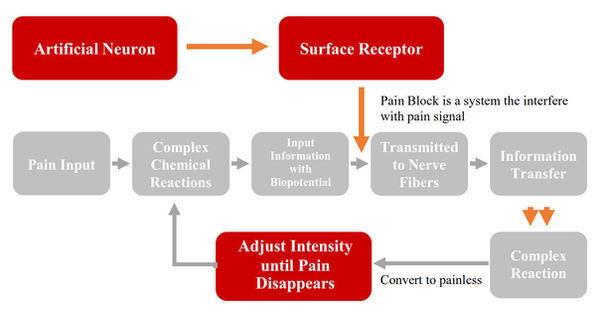


PAIN BLOCK is a transdermal pain relief electrical stimulation device that controls pain using non-invasive painless neural information control technology.
Transcutaneous pain relief electrical stimulator is a state-of-the-art medical device that non-invasively relieves pain by transmitting electrical signals through electrodes attached to the skin.
Equivalent device: CE certification in Europe in 2008, FDA approval in the US in 2009

Transcutaneous Electrical Nerve Stimulator
Principle of Pain Block Treatment
Generating Artificial painless signal
Signaling Artificial painless through electrodes attached to the skin
Normalizing the pain signal that are overgenerated by the artificial painless signal
Recognizing pain signals normally in the brain
The treatment principle of Pain Block is a state-of-the-art neuroscience medical technology developed in Europe and certified as a new medical technology by the American Medical Association.

Pain Block Scrambler Therapy
It is a system that recognizes the patient's pain signal as a pain-free signal by using neural control technology. Scrambler Therapy treatment, which has been recognized as a new medical technology in the United States as well, transmits electrical signals that control pain signals to the brain, allowing the person to perceive them as pain-free.Pain Block, which uses the principle of Scrambler Therapy treatment, was approved by the Korean Ministry of Food and Drug Safety as a medical device for pain relief such as chronic pain, intractable pain, post-operative pain, post-traumatic pain, and neuropathic pain.
-
Transmission of non-pain signals by acting on A-delta, C fiber
-
Randomized frequency of 42Hz~53Hz repeatedly stimulates the pain area

Principles and Features of Pain Block Treatment


Comparative clinical results of 26 chronic neuropathy patients under pharmacologic treatment and 26 patients under Scrambler TherapyReduction of pain caused by Scrambler Therapy is significantly higher than pharmacologic treatment· Patients under pharmacologic treatment after 1 month(-28%), Scrambler Therapy patients(-91%)
Applying Scrambler Therapy to 226 neuropathy patients withstrong drug-resistantFailed Back Surgery Syndrome(FBSS) – 45 patients,Sciatic and lumbar pain – 33 patients, Trigeminal neuralgia – 20 patients,Post Herpetical Neuralgia(PHN) – 21 patients,Post-surgery nerve lesion neuropathy – 21 patients,Pudendal neuropathy – 11 patients, Brachial plexus neuropathe – 12 patients, Low back pain(LBP) – 14 patients, Other neuralgia – 46 patients· VAS of each neuropathic pain decreased after Scrambler Therapy

Applying Scrambler Therapy to 18 CIPN patientsCIPN : Chemotherapy-induced peripheral neuropathy· CIPN Pain Score(0-10) result started at 5.81 and decreased to 2.38 at the end of the treatment which results in average reduction of 59% of pain score (pain of 4 patients gone to “0”)

Applying Scrambler Therapy to 33 terminal cancer patients with no drug response· VAS comparison before and after each treatment for clinical experiment result of curative effacement, and by the result pain is gone to “0” after treatment cycle

Scrambler Therapy –Clinical evidence


